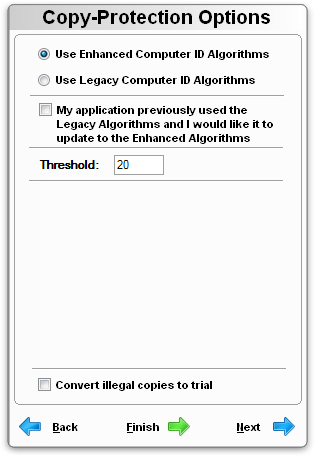
When a user activates your protected application, computer identifying information is saved to the license file. This ensures that the license file will only allow use of the protected application if the identification information of the current computer running the protection application matches what is in the license file. It is recommended that you use the Enhanced Computer ID Algorithms with a threshold value of 20 in most cases.
More high-level information can be found in our blog: Product Activation: Fingerprints, Copy Protection, Disconnected Computers.

Use Enhanced Computer ID Algorithms: Select this option to use the Enhanced Computer ID Algorithms.
Use Legacy Computer ID Algorithms: Select this option to use the Legacy Algorithms, which are described below.
My Application previously used the Legacy Algorithms and I would like it to update to the Enhanced Algorithms: Your protected application will automatically update licenses to use the Enhanced Algorithms. When using the option you will need to select the Legacy Algorithms you used in the previous protected application. See the Upgrading to the Enhanced Computer ID Algorithms topic for more information.
Convert illegal copies to trial: Check this option to convert your application back to a trial if the identification information of the computer does not match the license file. This option will not reset the trial, therefore if the amount of time for the trial has already passed then the application will be converted to an expired trial.
The legacy algorithms are no longer supported, and are only provided for backwards compatibility!
The following descriptions are for the Legacy Algorithms which have been deprecated. We will continue to make these algorithms available for backwards compatibility and when implementing network licensing.
BIOS: Calculates a checksum of the ROM BIOS area of the motherboard. Every different model of computer should indicate unique data in its ROM BIOS. Some models are also serialized, generating a different number for even identical machines. Note: The BIOS algorithm is no longer supported and is only provided for backwards compatibility.
Windows Product ID: Uses Windows ProductID and ProductKey created when Windows is installed. Automatically determines appropriate ID for supported Windows operating systems. Note: The Windows Product ID algorithm is no longer supported as of Windows 10 and later.
Hard Drive Serial: Identifies the drive volume serial number of the specified drive. DOS 4.0 or higher operating systems generate a random volume serial number for a drive during formatting. You can specify a specific drive letter (such as "C"), use "0" (zero) to use the drive letter where Windows is installed, or use "1" (one) to use the drive letter where the executable is located.
MAC Address: Calculates a number based upon the Ethernet (MAC) address of an installed Ethernet LAN adapter.
File Start: Identifies the starting location of a non-movable file. It is very unlikely for two computers to store the same file in the same location. A path and filename must be specified.
NetName: This algorithm is used with network licensing and uses the network file server and share name to generate a computer identifier. You must select this and at least one other algorithm - we recommend Windows Product ID and Hard Drive Serial. When the application is run from a network share, the NetName algorithm will be used exclusively. When the application is ran locally, such as on the server, the other algorithms selected (excluding NetName) will be used. Note: Network licensing is no longer supported.